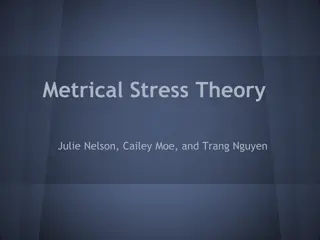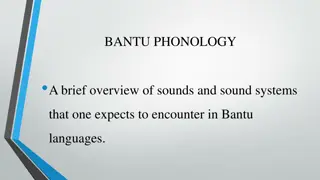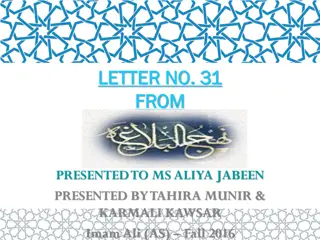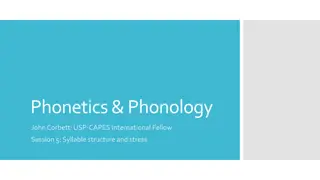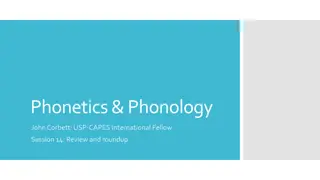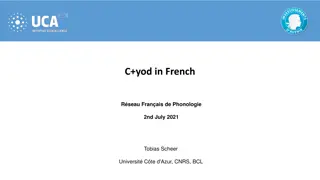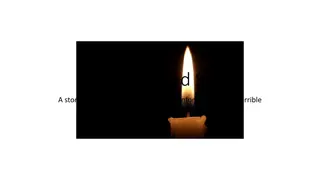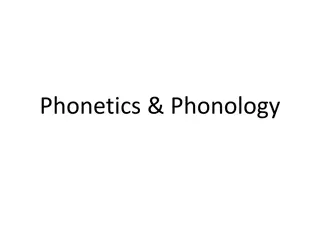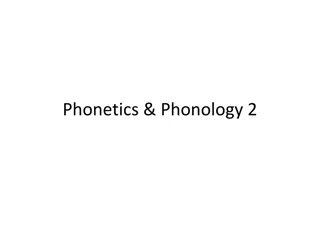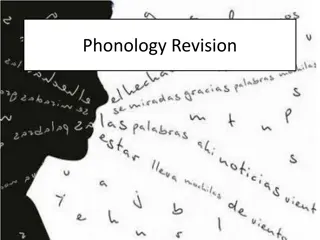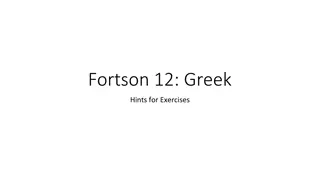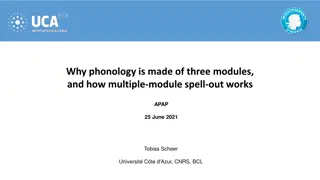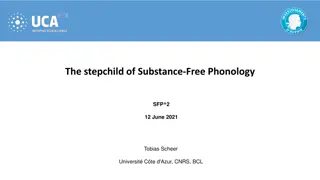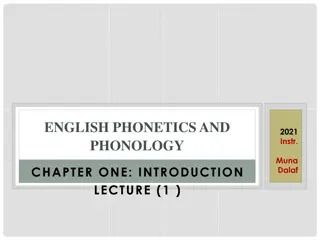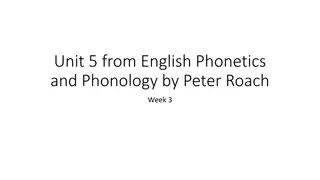Impacts of Son on Place & Lar in Phonology
In substance-free phonology, Son impacts Place & Lar in top-down but not bottom-up conditioning. Son's influence on lenition and debuccalization reveals indirect effects on skeletal positions, shaping phonological outcomes. Despite existing within different modules, Son's role in phonological processes challenges conventional distinctions. The study explores Son's impact on Place & Lar in phonological computation, shedding light on the intricate interactions within phonological systems.
Download Presentation

Please find below an Image/Link to download the presentation.
The content on the website is provided AS IS for your information and personal use only. It may not be sold, licensed, or shared on other websites without obtaining consent from the author.If you encounter any issues during the download, it is possible that the publisher has removed the file from their server.
You are allowed to download the files provided on this website for personal or commercial use, subject to the condition that they are used lawfully. All files are the property of their respective owners.
The content on the website is provided AS IS for your information and personal use only. It may not be sold, licensed, or shared on other websites without obtaining consent from the author.
E N D
Presentation Transcript
What substance-free phonology means for substance-free phonology The EGG week 2 1-5 August 2022 Brno Tobias Scheer Universit C te d'Azur
9. How could Son impact Place & Lar?
Son impacts Place & Lar Scheer, Tobias 2022. 3xPhonology. The Canadian Journal of Linguistics. recall, no bottom-up conditioning: Place and Lar do not impact Son top-down conditioning exists, though: Son does impact Place and Lar. Son bears on Lar devoicing (or more generally delaryngealization) in coda position. lenition: typical syllable-conditioned trajectories along the sonority scale involve laryngeal stages, e.g. ph > p > b > v in intervocalic position. Son bears on Place lenition: debuccalization f > h, s > h in coda position. unstressed vowels centralize (become schwa).
Son impacts Place & Lar this should not exist if Son and Place / Lar are located in different modules. Visibility table (Son-Place-Lar) Son bears on ? Son yes syllabification, infixation, stress assignment, lenition (intervocalic spirantization), etc. delaryngealization in coda position debuccalization in coda position *C is syllabified in a branching onset but only when voiced * infix lands after the first voiced C *velars palatalize but only when voiced voice assimilation * C is syllabified in a branching onset but only when labial * infix lands after the first labial C *C undergoes voice assimilation, but only if labial velars palatalize before front vowels ? Son Son Lar Lar Place Son yes yes no Lar Lar Place Place Lar Son no yes no Place Place Lar Place no yes
Son impacts Place & Lar but, encouraging: regular Place and regular Lar computation appears to be unimpacted by Son there is nothing like "velars palatalize before front vowels, but only if they are intervocalic" or "obstruent clusters CC undergo progressive voice assimilation, but only if the second consonant is engaged in a branching onset". this suggests that Place- and Lar-internal computation is indeed insensitive to Son, as predicted.
Son impacts Place & Lar the skeleton is the way out focus on the prototypical case of Son --> Place / Lar conditioning: lenition and fortition inoffensive cases: Son-internal computation (stop --> fricative / V__V) offensive: debuccalization involves the loss of Place primes and may thus not be described as a rearrangement of Son primes. positions are weak or strong, not segments segmental effects are due to positional strength / weakness thus the impact of Son on Place & Lar is indirect, not direct Son defines the strength of skeletal positions, which is then read off by Place and Lar
Son impacts Place & Lar this mechanism may be generalized struc(Son) bears on timing units and makes them more or less apt at sustaining (licensing) primes that are associated to them. a strong position is a position that allows for a large number of primes to be associated, while a weak position can only sustain a few, or indeed no prime. timing units do not belong to any particular module but rather instantiate the temporal and linear sequence. the primes of all three modules that co-define a segment are attached to the timing unit that defines this segment Son defines the strength of skeletal positions, which are then read off by Place and Lar
Son impacts Place & Lar three modules and a skeleton each module has its own vocabulary corresponding to its domain Sonority Module a | C b | V c | C carries out computation based on this vocabulary skeleton (specified for C and V) may be impacted by the status of the skeletal slot it is attached to (strong, weak) Laryngeal Module Place Module this status is defined by Son.
10. Interim Summary
where we stand Son vs. Place & Lar Place vs. Lar Place & Lar never impact Son impact of Son on Place & Lar is indirect: Son defines positional strength Son primes are hard-wired (innate: perceptual salience), Place & Lar primes are emergent Place & Lar computation is arbitrary, Son computation is not (rule-governed)
Sandler, Wendy 1993. A sonority cycle in American Sign Language. Phonology 10: 243-279. Hulst, Harry van der 1995. Head- dependency relations in the representation of signs. Sign language research 1994. Proceedings of the 4th European congress on Sign language research, edited by H. Bos & T. Schermer, 11-38. Hamburg: Signum Press. Sandler, Wendy & Diane Lillo-Martin 2006. Sign Language and Linguistic Universals. Cambridge: CUP. Stokoe, William C. 1978 [1960]. Sign language structure. Silver Spring, MD: Linstok Press. magical number 3 vocal-sign modality: both seem to be made of three domains vocal: Son, Place, Lar sign: movement, location, handshape
magical number 3 vocal-sign modality: both seem to be made of three domains movement = Son "some kind of movement is necessary for a well-formed sign, just as a vowel, or, in its absence, some other sonorous element, is necessary for a well-formed syllable in spoken language. It has also been noted that movement is perceptually salient, just as vowels are perceptually salient in spoken language" (Sandler 1993: 253). Berent, Iris, Amanda Dupuis & Diane Brentari 2013. Amodal Aspects of Linguistic Design. Plos One 8: article e60617. Son in the vocal and movement in the signed modality may be instantiations of the same module whose modality-unspecific domain is perceptual salience. overview: Sandler & Lillo-Martin (2006: 235-245)
11. Multiple-module spell-out
segment integrity the three module architecture raises a number of non-trivial questions how can Place and Lar distinguish consonants and vowels? segment integrity in the lexicon: what does a lexical entry look like? upon spell-out how can primes that belong to different modules and vocabularies concur in the pronunciation of a single segment? what is the glue that holds the three sets of primes together? what exactly is spelt out?
11.1. Timing units are specified for consonant- and vowelhood
CV skeleton Clements, George & Samuel Keyser 1983. CV Phonology. A Generative Theory of the Syllable. Cambridge, Mass.: MIT Press. Place computation is informed of whether the items computed belong to a consonant or a vowel vowel harmony is only among vowels in a regular palatalization, the trigger is a vowel and the target, a consonant information about vowel- and consonanthood is absent from the Place system, though. it must therefore be present in the only other structure that Place has access to: the timing units that represent linearity. ==> the skeleton is a CV-skeleton (Clements & Keyser 1983)
11.2. Segment integrity I: lexical entry
segment integrity: lexical entry one-to-multiple morpho-syntax the situation where a single lexical entry is defined by items that belong to different vocabularies is known from the morpho-syntax - phonology interface. PF LF the lexical entry of a morpheme stores three types of information written in three distinct vocabularies that are accessed by three different computational systems: morpho-syntax (using vocabulary items such as number, person, animacy, etc.) semantics (LF-relevant properties) phonology (vocabulary items such as occlusion, labiality, voicing etc.).
segment integrity: lexical entry lexical entry of the morpheme "cat" M307 [<Morph-synt = animate, count etc.>, <Sem = "idea of cat">, <Phon = /k t/>]morph. in the same way, the lexical identity of a segment contains several compartments that host items from three distinct vocabularies. lexical entry of the segments of "cat" P12 [<Son = stop>, <Place = velar>, <Lar = voiceless>]segment P16 [<Son = stop>, <Place = dental>, <Lar = voiceless>]segment P19 [<Son = vowel>, <Place = front low>, <Lar = >]segment (= k) (= t) (= )
segment integrity: lexical entry each vocabulary is then accessed by the relevant computational system: Son the computation that builds syllable structure is specific to Son and can only parse this vocabulary. hence only Son primes are projected and the result of the computation, struc(Son), contains no information pertaining to Place or Lar. this is why other computations which occur above the skeleton and take into account items in that area are unable to access anything else than Son primes and struc(Son): infixation etc. in the same way, Place computation (e.g. palatalization) accesses only Place primes and outputs struc(Place). Lar computation (e.g. voice assimilation) only reads Lar primes and produces struc(Lar).
11.3. Segment integrity II: spell-out
segment integrity: spell-out multiple-to-one Place Lar Son at the phonology-phonetics interface, Son, Place and Lar do not see each other cannot communicate but are segment-bound, i.e. must co-define the same segment phonetics multiple-to-one therefore segment integrity can only exist if the items of the three computational systems are related through a third player that defines the segment: the skeleton. Place Lar Son C V C V x ERB phonetics
11.4. What exactly is spelt out I
what exactly is spelt out I spell-out = assigning a pronunciation to phonological items. spell-out cannot proceed prime by prime for a segment defined by , , first will be converted into a phonetic item, followed by the conversion of , producing a sequence of items on the phonetic side. C V C V | , , phonetics would not "know" that the representatives of and need to be pronounced simultaneously, rather than in sequence. segments are spelt out segment integrity requires that segments be spelt out, and the only definition of the segment is by timing units.
what exactly is spelt out I C V C V | but what about geminates and long vowels where two timing units are associated to one set of primes? , , spell-out cannot proceed timing unit by timing unit this would create two identical phonetic items: [ , ] associated to a C would be spelt out twice. what is realized, though, is not two times the consonant in question, but the consonant with a longer duration spell-out instruction C V C root nodes are spelt out for every root node present on the phonological side, a spell-out instruction is searched that contains all items affiliated. x | ERB value , this means that languages possess exactly as many spell-out instructions as there are phonemes (segments), i.e. objects that are phonologically distinct.
11.5. What exactly is spelt out II: Struc(Son) is not
phonological computation spell-out what exactly is spelt out II phonology phonology for any given alternation, how do we know whether it is due to phonological computation or spell-out? | R | N | x | a | R | N | x | a | R | N | x | a | R | N | x | a O | x | s C | x | O | x | g C | x | r O | x | s C | x | O | x | g C | x | r l-vocalization in coda position e.g. in Braz. Portuguese: sal "salt" - saw-gar "to salt" w / coda phonological computation spell-out w w phonetics spell-out instruction: Coda | spell-out w phonetics w spell-out instruction: w w Struc(Son) absent Struc(Son) present
what exactly is spelt out I can spell-out make reference to Struc(Son)? NO if yes lenition and fortition are subjected to the arbitrariness of spell-out thus the existence of mismatches (or crazy matches) that are typical for spell-out relations is expected in Coda w / #__ anti- l vocalization these patterns appear to be absent from the record in Chabot's inventory of crazy rules features no cases of a syllabic conditioning This suggests that struc(Son) is not used in spell-out instructions
what exactly is spelt out I only primes are spelt out: struc(Son) is absent from spell-out in fact we knew that: it follows from what was said before spelling out an item is the process of assigning it a phonetic value. Items of struc(Son) do not have any phonetic correlate, though, and therefore cannot be spelt out. computation of items above the skeleton is not arbitrary because Son items are meaningful. there are no crazy rules above the skeleton thus the result of Son computation cannot be messed up in spell-out otherwise we would observe crazy rules above the skeleton.
what exactly is spelt out I only primes are spelt out: struc(Son) is absent from spell-out conclusion Son primes may experience arbitrary distortion through spell-out w but struc(Son) may not: it always reaches (language-specific) phonetics faithfully * in Coda
what exactly is spelt out II phonology | R | N | x | a | R | N | x | a possible pattern: 1. w in Coda 2. w phon. computation spell-out O | x | s C | x | O | x | g C | x | r result: ALL w's of the language (lexical or computed) appear as phonological computation impossible (crazy) pattern: 1. in Coda spell-out w spell-out result: lexical appears as only in Coda phonetics spell-out instruction: w
what exactly is spelt out II you may be fooled, though: seemingly arbitrary Son computation 1. b 2. phon. computation spell-out this creates the impression of an arbitrary computation b > but in fact involves regular computation followed by a spell-out mismatch
that's all [congratulations if you made it down to this slide]
References Bach, Emmon & R. T. Harms 1972. How do languages get crazy rules? Linguistic change and generative theory, edited by Robert Stockwell & Ronald Macaulay, 1-21. Bloomington: Indiana University Press. Bakst, Sarah & Jonah Katz 2014. A Phonetic Basis for the Sonority of [X]. UC Berkeley Phonology Lab Annual Report 10: 11- 19. Berent, Iris 2013. The Phonological Mind. Cambridge: CUP. Berent, Iris, Tracy Lennertz, Jongho Jun, Miguel A. Moreno & Paul Smolensky 2008. Language universals in human brains. Proceedings of the National Academy of Sciences of the United States of America 105: 5321 5325. Bloch, Bernard & George Trager 1942. Outline of linguistic analysis. Baltimore: Linguistic Society of America. Carruthers, Peter 2006. The Architecture of the Mind. Massive modularity and the flexibility of thought. Oxford: Clarendon Press. Carvalho, Joaquim Brand o de 2017. Deriving sonority from the structure, not the other way round: A Strict CV approach to consonant clusters. The Linguistic Review 34: 589-614. Chabot, Alex 2019. What's wrong with being a rhotic? Glossa 4: article 38. Chabot, Alex 2021. Possible and impossible languages. Naturalness, third factors, and substance-free phonology in the light of crazy rules. Ph.D dissertation, Universit C te d'Azur. Clements, George 2009. Does sonority have a phonetic basis? Contemporary views on architecture and representations in phonological theory, edited by Eric Raimy & Charles Cairns, 165-175. Cambridge, Mass.: MIT Press. Clements, George & Elizabeth Hume 1995. The Internal Organization of Speech Sounds. The Handbook of Phonological Theory, edited by John Goldsmith, 245-306. Oxford: Blackwell. Collins, John 2017. Faculties and Modules: Chomsky on Cognitive Architecture. The Cambridge companion to Chomsky, edited by James McGilvray, 217-234. Cambridge: CUP. Coltheart, Max 1999. Modularity and cognition. Trends in Cognitive Sciences 3: 115-120.
References de Lacy, Paul 2002. The formal expression of markedness. Ph.D dissertation, University of Massachusetts. Dresher, Elan 2014. The arch not the stones: Universal feature theory without universal features. Nordlyd 41: 165-181. Fletcher, Harvey 1972 [1929]. Speech and hearing in communication. 2nd edition Huntington, N.Y.: Krieger. Fodor, Jerry 1983. The modularity of the mind. An essay on faculty psychology. Cambridge, Mass.: MIT-Bradford. Gerrans, Philip 2002. Modularity reconsidered. Language and Communication 22: 259-268. Gordon, Matthew 2006. Syllable Weight. Phonetics, Phonology, Typology. New York: Routledge. Gordon, Matthew, Edita Ghushchyan, Bradley McDonnell, Daisy Rosenblum & Patricia Shaw 2012. Sonority and central vowels: A cross-linguistic phonetic study. The sonority controversy, edited by Steve Parker, 219-256. Berlin: de Gruyter. Hale, Mark & Charles Reiss 2000. Substance Abuse and Dysfunctionalism: Current Trends in Phonology. Linguistic Inquiry 31: 157-169. Hale, Mark & Charles Reiss 2008. The Phonological Enterprise. Oxford: OUP. Harris, John 1990. Segmental complexity and phonological government. Phonology 7: 255 300. WEB. Harris, John 2006. The phonology of being understood: further arguments against sonority. Lingua 116: 1483-1494. Heffner, Roe-Merrill S. 1950. General phonetics. Madison: The University of Wisconsin Press. Hulst, Harry van der 1995. Head-dependency relations in the representation of signs. Sign language research 1994. Proceedings of the 4th European congress on Sign language research, edited by H. Bos & T. Schermer, 11-38. Hamburg: Signum Press. Hulst, Harry van der 1999. Features, segments and syllables in Radical CV Phonology. Phonologica 1996, edited by John Rennison & Klaus K hnhammer. The Hague: Holland Academic Graphics. Jackendoff, Ray 1997. The Architecture of the Language Faculty. Cambridge, Massachusetts: MIT Press. Jackendoff, Ray 2002. Foundations of Language. Brain, Meaning, Grammar, Evolution. Oxford: Oxford University Press. Marr, David 1982. Vision. San Francisco: Freeman.
References Odden, David forth. Radical Substance Free Phonology and Feature Learning. To appear in the Canadian Journal of Linguistics. Ohala, John 1992. Alternatives to the sonority hierarchy for explaining segmental sequential constraints. Papers from the Parasession on the Syllable, Chicago Linguistic Society, 319-338. Chicago: Chicago Linguistic Society. Parker, Steve 2008. Sound level protrusions as physical correlates of sonority. Journal of Phonetics 36: 55-90. Parker, Steve 2011. Sonority. The Blackwell Companion to Phonology, edited by Marc van Oostendorp, Colin J. Ewen, Elizabeth Hume & Keren Rice, 1160-1184. New York: Wiley-Blackwell. Paster, Mary 2006. Phonological conditions on affixation. Ph.D dissertation, University of California at Berkeley. P chtrager, Markus 2006. The structure of length. Ph.D dissertation, University of Vienna. WEB. P chtrager, Markus Alexander & Jonathan Kaye 2013. GP2.0. SOAS Working Papers in Linguistics and Phonetics 16: 51-64. Price, C. J. 1980. Sonority and syllabicity: acoustic correlates of perception. Phonetica 37: 327-343. Robbins, Philip 2017. Modularity of Mind. The Stanford Encyclopedia of Philosophy (Winter 2017 Edition), edited by Edward N. Zalta. Online resource https://plato.stanford.edu/archives/win2017/entries/modularity-mind/. Rumelhart, David E., James L. McClelland & the PDP Research Group (eds.) 1986. Parallel Distributed Processing: Exploration in the Micro-Structure of Cognition. 2 vols. Cambridge, Mass.: MIT Press. Sabbatini, Renato 1997. Phrenology: the History of Brain Localization. Brain & Mind 1: [electronic resource: www.cerebromente.org.br/n01/index_i.htm]. Samuels, Bridget 2009. The structure of phonological theory. Ph.D dissertation, Harvard University. Samuels, Bridget, Samuel Andersson, Ollie Sayeed & Bert Vaux forth. Getting ready for primetime: paths to acquiring substance-free phonology. Canadian Journal of Linguistics. Sandler, Wendy 1993. A sonority cycle in American Sign Language. Phonology 10: 243-279.
References Scheer, Tobias 2015. How diachronic is synchronic grammar? Crazy rules, regularity and naturalness. The Oxford Handbook of Historical Phonology, edited by Patrick Honeybone & Joseph C. Salmons, 313-336. Oxford: OUP. Scheer, Tobias 2016. Melody-free syntax and phonologically conditioned allomorphy. Morphology 26: 341-378. Scheer, Tobias 2019. Phonetic arbitrariness: a cartography. Phonological Studies 22: 105-118. Scheer, Tobias 2019. Sonority is different. Studies in Polish Linguistics 14 (special volume 1): 127-151. Scheer, Tobias 2022. 3xPhonology. Canadian Journal of Linguistics. Schwartz, Geoff 2013. A representational parameter for onsetless syllables. Journal of Linguistics 49: 613-646. Schwartz, Geoff 2017. Formalizing modulation and the emergence of phonological heads. Glossa 2, article 81. Segal, Gabriel 1996. The modularity of theory of mind. Theories of Theories of Mind, edited by P. Carruthers & P. Smith, 141- 157. Cambridge: CUP. S g ral, Philippe & Tobias Scheer 2008. Positional factors in lenition and fortition. Lenition and Fortition, edited by Joaquim Brand o de Carvalho, Tobias Scheer & Philippe S g ral, 131-172. Berlin: Mouton de Gruyter. WEB. Smith, Jennifer L. & Elliott Moreton 2012. Sonority variation in Stochastic Optimality Theory: Implications for markedness hierarchies. The Sonority Controversy, edited by Steve Parker, 167-194. Berlin: de Gruyter. Smolensky, Paul 1988. On the proper treatment of connectionism. Brain and Behavioural Sciences 11: 1-74. Smolensky, Paul 2003. Connectionism. International Encyclopedia of Linguistics, edited by William Frawley, 383-386. Oxford: OUP. Stevens, Kent A. 2012. The vision of David Marr. Perception 41: 1061-1072. Stilp, Christian E. & Keith R. Kluender 2010. Cochlea-scaled entropy, not consonants, vowels, or time, best predicts speech intelligibility. PNAS 107: 12387-12392. van Wyhe, John 2004. Phrenology and the Origins of Victorian Scientific Naturalism. London: Ashgate.
References Volenec, Veno & Charles Reiss 2018. Cognitive Phonetics: The Transduction of Distinctive Features at the Phonology Phonetics Interface. Biolinguistics 11: 251-294. Wright, Richard 2004. A review of perceptual cues and cue robustness. Phonetically Based Phonology, edited by Bruce Hayes, Donca Steriade & Robert Kirchner, 34-57. Cambridge: CUP. Yu, Alan C. L. 2007. A Natural History of Infixation. Oxford: OUP.




